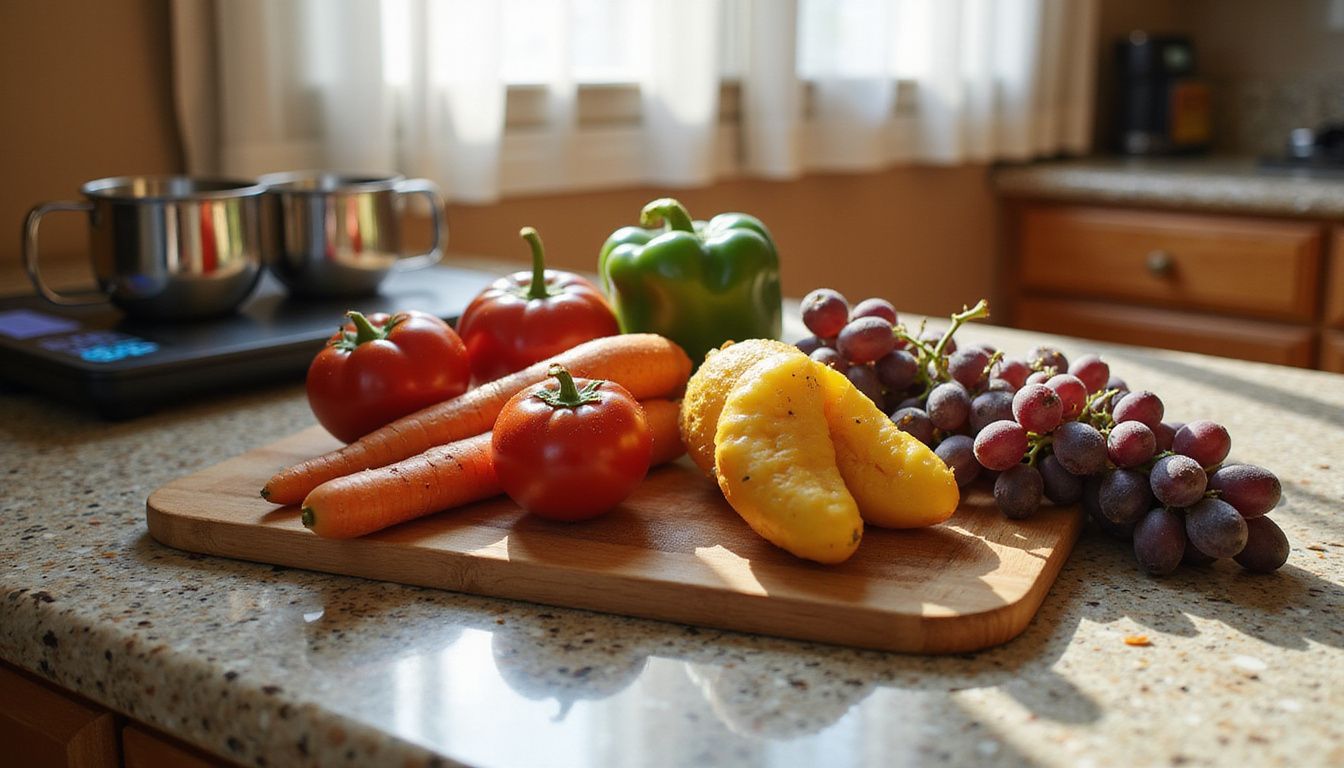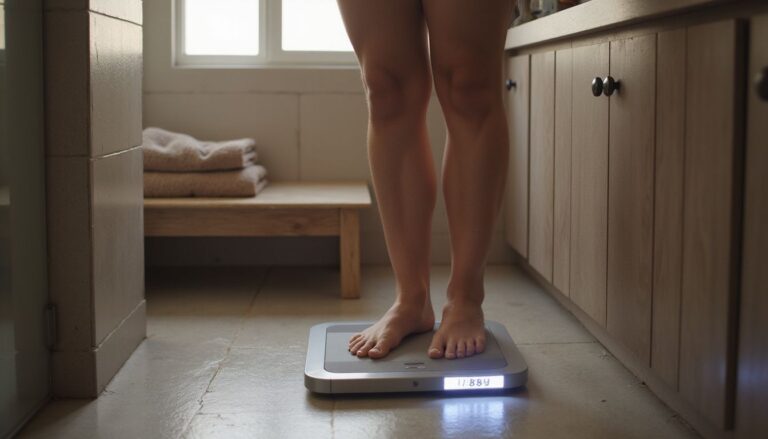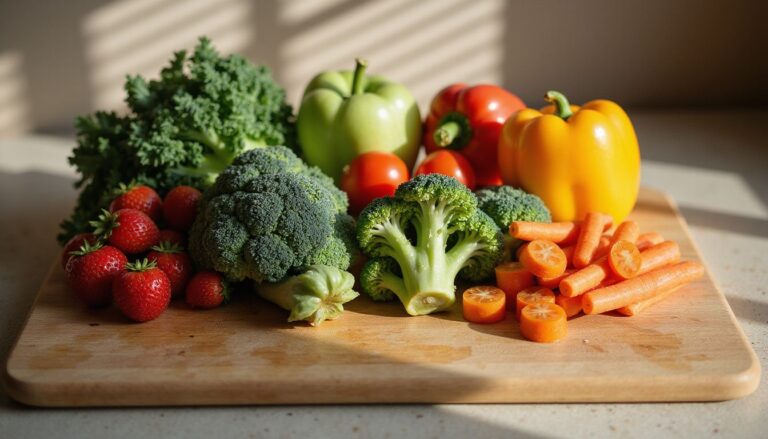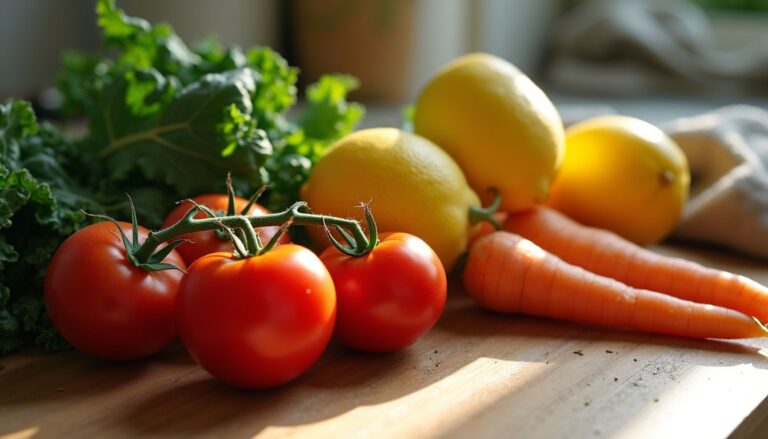7-Day Diet Plan For Weight Loss Free: A Meal Plan To Kickstart Your Weight Loss Journey
Our Nutrition Assistant AI Suite will transform your body. You will lose fat, get toned, and build muscle. Gain confidence and optimal health.
Starting a new diet can feel frustrating when results stall. This simple 7-day meal plan gives you structure, clear portions, and easy recipes so you can take action fast. If you want a practical plan for weight loss, you are in the right place.
Across the next week, you will get step-by-step menus, shopping guidance, and quick prep ideas from a registered dietitian approach. You will also learn how to adjust meals to fit your calorie needs without losing flavor or nutrition. Use this guide to make healthy eating easier, one day at a time.
Key Takeaways
- The 7-day diet plan offers structured meals at 1,200 to 2,000 calories per day, with guidance inspired by registered dietitians to support safe, steady weight loss.
- Daily menus aim for at least 72 to 86 grams of protein and 30 to 43 grams of fiber to improve fullness and protect muscle during a calorie deficit.
- Whole foods are the focus, including lean proteins, whole grains, fruits, and vegetables, with zero added sugars following American Heart Association limits.
- Portion-controlled recipes, analyzed with nutrition software, help manage blood sugar and support stable energy all week.
- Nutrition experts highlight the need to personalize portions and calories for your body and goals, not just chase quick results.
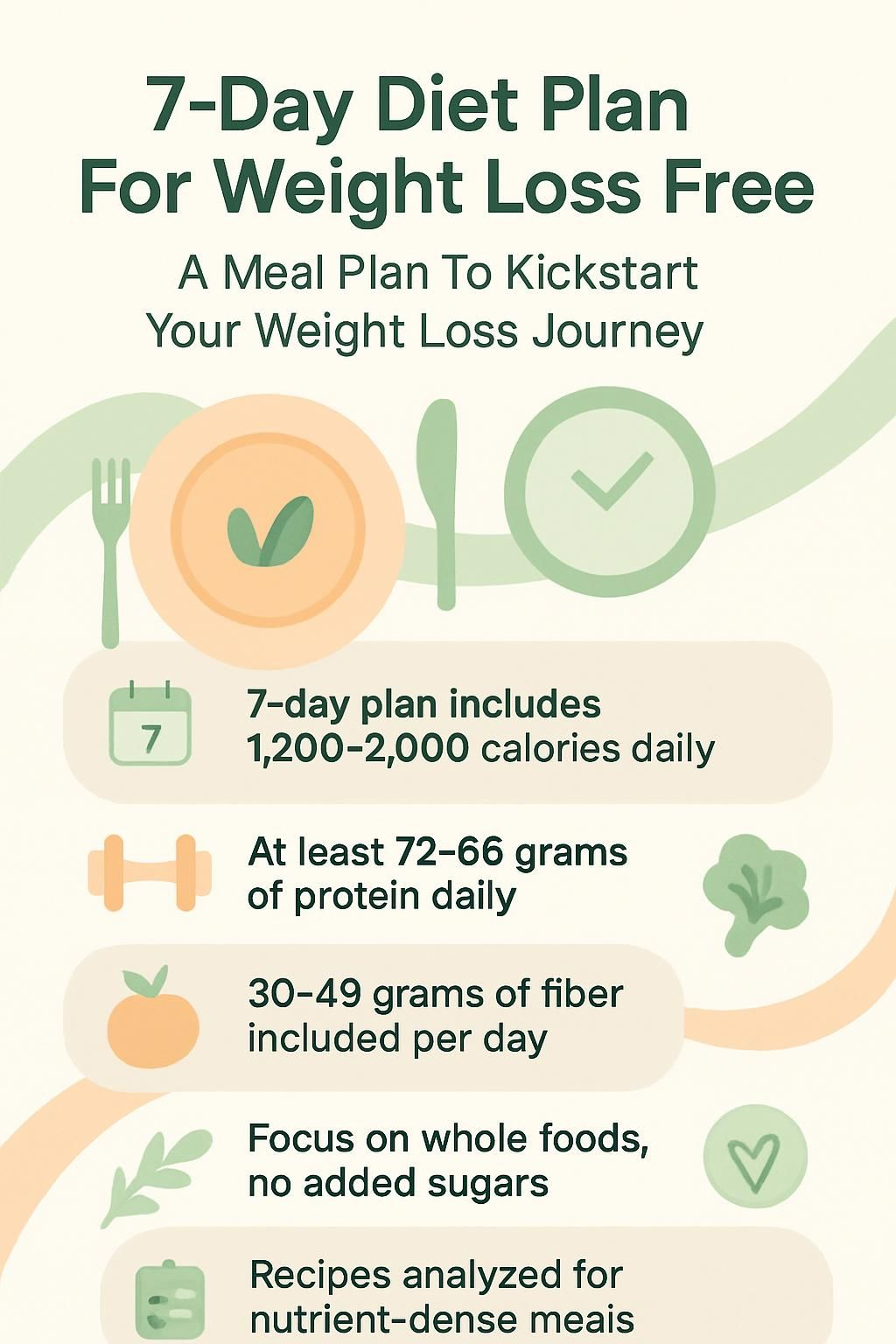
What Is the 7-Day Diet Plan and How Does It Work?

A 7-day diet meal plan is a clear, one-week guide that maps out your meals and snacks. It gives you breakfast, lunch, dinner, and snack ideas for every day, all in the right portions. The goal is simple, choose healthier foods, hit your protein and fiber targets, and keep calories in a safe range.
What Is a 7-Day Diet Plan?
This weekly plan lays out meals that fit common calorie targets, usually 1,200 to 2,000 calories per day. You can pick a level that aligns with your size, activity, and goals. Each menu centers on whole foods with no added sugars and includes high protein and fiber for better fullness.
Typical options include a berry smoothie at breakfast, a chickpea salad at lunch, and baked fish with steamed broccoli for dinner. Nutrition analysis tools, such as ESHA Food Processor, estimate calories and key nutrients so you can eat with confidence.
Choosing whole ingredients in your meal plan makes it easier to lose weight while feeling satisfied.
Planning my week ahead cut stress and helped me control portions without feeling deprived. Having meals ready also kept my evenings calm and my choices consistent.
How Does It Help with Weight Loss?
The plan creates a calorie deficit, which means you eat fewer calories than you use. Higher protein, about 72 to 86 grams per day, and higher fiber, 30 to 43 grams per day, help you feel full and reduce snacking. Lean proteins like chicken breast, eggs, tuna packed in water, and strained yogurt support muscle while your body burns fat.
Whole grains, vegetables, fruit, and healthy fats such as olive oil make meals satisfying. Keeping added sugars under the American Heart Association limits, 6 teaspoons for women and 9 for men, removes many empty calories. Studies link nutrient-dense diets with less visceral fat, the deep belly fat that raises risk for type 2 diabetes and heart disease.
Key Features of This Meal Plan
This 7-day meal plan is built around whole foods and portion control. It uses evidence-based targets that promote fullness, steady energy, and healthier habits.
What Are Balanced Macronutrient Ratios?
Macronutrients are protein, carbohydrates, and fat. Balancing them helps you feel full and energized. In this plan, you get at least 72 to 86 grams of protein and 30 to 43 grams of fiber daily. Lean proteins such as chicken or tofu support muscles while fiber from beans and vegetables supports digestion.
Carbohydrates come from whole grains like brown rice and oats, and fats come from foods such as olive oil or peanut butter. A sample day includes about 98 grams of protein, 168 grams of carbs, and 57 grams of fat. Sodium stays moderate, often under 1,700 milligrams per day.
When I followed these targets using software-based menu plans, I felt full longer and had fewer cravings in the afternoon.
Why Choose Low-Calorie Meals?
Lower calorie meals help create a deficit that leads to weight loss. The plan uses 1,200 to 2,000 calories per day, ranges aligned with the Dietary Guidelines for Americans 2020 to 2025. Portions are measured, such as one slice of whole grain toast with natural peanut butter or a medium apple for a snack.
Here is what that looks like in practice, Day 3 totals about 1,499 calories and Day 5 lands near 1,491 calories. If your energy needs are higher, you can add nutrient-dense foods like kefir, avocado toast, or extra vegetables. Avoid very low calorie diets without medical oversight.
How Does Focusing on Whole, Unprocessed Foods Help?
Whole foods give more nutrients per bite. Vegetables, fruits, beans, and whole grains deliver fiber that helps with fullness and blood sugar control. For example, one cup of steamed broccoli or a medium apple adds natural fiber without added sugar.
Choosing lean proteins such as eggs or chicken adds protein without extra additives. This plan contains zero grams of added sugar, which many people exceed in a typical day. Labels now list added sugar separately, making smarter choices easier.
Some foods, like onions, garlic, legumes, oats, and wheat, contain inulin. Inulin is a type of fiber that supports gut health and may help manage hunger. On days I swap sweets for a piece of fruit with nuts or sliced roast beef with a baked potato, my energy stays steady and cravings fade.
Benefits of Following a 7-Day Diet Plan
A 7-day diet plan gives you structure, which reduces guesswork and builds momentum. You can see small wins in one week while learning habits that last longer.
How Does It Provide a Quick Kickstart to Weight Loss?
Sticking to 1,200 to 2,000 calories per day creates an early calorie gap. Lean proteins such as grilled chicken and Greek yogurt push protein intake toward 103 grams on some days. Fiber from quinoa, beans, cucumbers, and berries helps you stay satisfied.
Reducing visceral fat is a key advantage. This type of fat raises the risk of diabetes and heart disease. Add brisk walking or cycling to improve results across the week. A sample Day 1 provides about 1,507 calories with a balanced mix to keep energy steady.
Can It Improve Energy Levels?
Meals built on whole grains, fruits, vegetables, and lean protein provide slow, steady fuel. Avoiding added sugar prevents energy spikes and crashes. Keeping sodium in a moderate range, about 1,424 to 1,734 milligrams, also supports hydration and reduces sluggishness.
Breakfasts and lunches include complex carbs from toast or whole grain bread plus fiber-rich vegetables. That combo slows digestion and supports stable blood sugar. At least 72 grams of protein per day from foods like eggs, chicken salad, hummus, or nuts helps preserve muscle and supports metabolism.
After swapping chips for celery with hummus on Day 4, I had fewer afternoon slumps and better focus.
How Does It Help with Portion Control?
Each daily menu lists clear portion sizes for every meal and snack. A typical day might include 1 sliced tomato, half a cup of brown rice, or one serving of fruit, which makes eating the right amount much easier. Many recipes use simple cooking methods, such as grilling, roasting, steaming, baking, stir frying, or sauteing, to keep calories in check.
If hunger hits, add extra vegetables or a pear for more fiber. This structure teaches you how much to put on your plate, which is a skill that helps long after the week ends.
What Is Nutritional Awareness and Why Is It Important?
Nutritional awareness means understanding what you eat and how it affects your body. You learn how to read labels, spot added sugars, and monitor calories, protein, carbs, fat, fiber, and sodium. The CDC and USDA recommend limiting added sugars, under 6 teaspoons a day for women and under 9 for men.
Patterns like the Australian Guide to Healthy Eating promote balanced choices, such as milk, vegetable-based soups, citrus fruits, and whole grains. Tracking intake helps you avoid processed meals high in refined oils or sugars. It also supports a healthier mindset and reduces pressure from diet culture. For major changes, talk with a healthcare professional.
Day 1 Meal Plan
Day 1 focuses on simple, filling meals that set the tone for the week. You will pair lean protein with fiber-rich fruits and vegetables for steady energy.
What Should I Eat for Breakfast on Day 1?
Have oatmeal topped with sliced orange and a small handful of nuts such as almonds or walnuts. Oatmeal provides fiber for fullness and healthy digestion. Oranges add vitamin C and sweetness while nuts deliver protein and healthy fats.
This breakfast takes under 10 minutes and includes only whole foods with no added sugar. It sets you up well for lunch and helps control mid-morning hunger.
What Is a Healthy Lunch on Day 1?
Build a salad with grilled chicken or turkey, roasted bell pepper, and leafy greens. Measure about 3 ounces of meat and 2 cups of vegetables to keep portions on target. Skip packaged snacks and white bread. Use a vinaigrette made with olive oil, vinegar, mustard, and black pepper.
Choose water or unsweetened tea instead of sugary drinks to support stable blood sugar. This lunch comes together in under 30 minutes and keeps you full all afternoon.
What Is a Good Dinner Option for Day 1?
Serve grilled chicken breast with steamed broccoli and half a cup of cooked quinoa. This balanced meal offers about 350 to 400 calories, at least 30 grams of protein, more than 6 grams of fiber, and under 400 milligrams of sodium.
Everything is whole and unprocessed. This dinner takes less than 30 minutes and helps prevent late-night snacking while you stay on track.
Day 2 Meal Plan
On Day 2, you will keep building habits that support weight loss. Simple swaps like whole grain bread and unprocessed proteins make a big difference.
What Is a Healthy Breakfast on Day 2?
Choose scrambled eggs with spinach or cottage cheese with fresh berries. Both options deliver protein and fiber to support morning energy. Keep portions reasonable and avoid added sugars found in sweet rolls or flavored yogurts.
An egg sandwich on whole grain bread is another quick choice that fits the plan.
What Should I Have for Lunch on Day 2?
Try grilled chicken breast with brown rice and steamed broccoli. Measure 4 ounces of chicken, half a cup of cooked rice, and 1 cup of broccoli. This trio provides lean protein, complex carbs, and fiber. It can be cooked in under 30 minutes and contains no added sugars.
Nutrition guidelines in many countries support pairing lean protein with whole grains and vegetables for steady energy. This pattern helps you reach your Day 6 and Day 7 goals with less guesswork.
What Is a Nutritious Dinner for Day 2?
Grilled salmon with quinoa and steamed broccoli is a balanced dinner that is quick to make. Salmon brings protein and omega-3 fats. Quinoa and broccoli add fiber and nutrients without excess calories.
Here is a simple breakdown for one plate:
- Calories: 420
- Protein: 35 grams
- Fiber: 8 grams
- Fat: 15 grams, mostly from the fish
This meal is easy to prepare on a weeknight and supports your weight loss goals.
Day 3 Meal Plan
Day 3 keeps your meals balanced and satisfying, a steady rhythm makes healthy eating easier.
What Should I Eat for Breakfast on Day 3?
Scramble two eggs with chopped spinach. Add one slice of whole grain toast for complex carbs, plus half a cup of blueberries for natural sweetness and antioxidants. No added sugars are needed when fruit provides flavor.
Prep takes less than 15 minutes and this meal helps you stay full until lunch.
What Is a Balanced Lunch on Day 3?
Enjoy grilled chicken breast, quinoa, and steamed broccoli with sliced avocado. Chicken provides protein, quinoa and broccoli supply fiber, and avocado adds healthy fats. Everything is minimally processed with zero added sugar.
One cup of cooked quinoa offers about 5 grams of fiber and 8 grams of protein. Balanced plates like this help steady blood sugar and reduce afternoon cravings.
What Is a Healthy Dinner Option for Day 3?
Have grilled salmon with steamed broccoli and brown rice. A 3-ounce serving of salmon gives about 22 grams of protein. The combination supplies protein, fiber, and complex carbs without extra additives.
You can prepare this dinner in under 30 minutes. It is filling yet light enough to support a good night of sleep.
Day 4 Meal Plan
Day 4 brings variety, which keeps motivation high and taste buds happy.
What Is a Good Breakfast Choice on Day 4?
Make scrambled eggs with sauteed spinach and diced tomatoes. Add a slice of whole grain toast for extra fiber. This quick breakfast meets your protein and fiber needs without added sugars or processed ingredients.
It takes less than 15 minutes and sets up a strong morning.
What Should I Eat for Lunch on Day 4?
Prepare grilled chicken breast with quinoa and roasted broccoli. Finish with a light drizzle of olive oil. This meal uses fresh, whole ingredients and skips added sugars.
Expect about 30 grams of protein and at least 7 grams of fiber per serving while keeping calories under control[1]. It is simple to assemble and keeps you satisfied for hours.
…
[1] United States Department of Agriculture (USDA), FoodData Central
What Are Dinner Ideas for Day 4?
Bake salmon and serve it with steamed broccoli and quinoa. Season with olive oil and lemon juice instead of sugary sauces. Aim for about 4 ounces of fish to meet nutrition goals without too many calories.
Protein from fish, healthy fats from olive oil, and carbs from quinoa support fullness and recovery. The entire dinner cooks in about 30 minutes.
Day 5 Meal Plan
Day 5 keeps the focus on lean protein, fiber, and flavor. These choices support progress while keeping prep simple.
What Is a Nutritious Breakfast for Day 5?
Cook a spinach and mushroom omelet with two eggs. Add a slice of whole grain toast and a cup of fresh berries. Protein from eggs and fiber from toast and fruit improve satiety.
This meal avoids processed items and added sugars. It takes less than 10 minutes and holds you until lunch.
What Should I Have for Lunch on Day 5?
Grill 4 ounces of skinless chicken breast and place it over a large bed of mixed greens. Add half a cup of chickpeas and dress with one tablespoon of extra-virgin olive oil plus lemon juice. These whole foods bring protein, fiber, and healthy fats together.
Measure portions with cups or a food scale to stay within your calorie target. Prepping salads like this ahead helped me skip takeout and stay full all afternoon.
Research suggests meals higher in protein and fiber may improve satiety and reduce overall calorie intake, which helps with weight control, Smith et al., 2017.
What Is a Healthy Dinner on Day 5?
Grill a chicken breast and serve it with steamed broccoli and quinoa. This plate supports your protein and fiber targets, so evening hunger stays under control.
Studies indicate protein-rich dinners help preserve muscle and promote fullness1. Using whole foods such as chicken, vegetables, and whole grains keeps added sugars off your plate.
Expect about 28 grams of protein from the chicken and roughly 6 grams of fiber from broccoli and quinoa2. These choices align with evidence-based strategies for weight management3.
___
1: Leidy HJ et al., The Role of Protein in Weight Loss and Maintenance. The American Journal of Clinical Nutrition, 2015.
2: USDA FoodData Central, Chicken breast cooked; Broccoli cooked; Quinoa cooked
3: Academy of Nutrition and Dietetics, Effective Strategies for Weight Management, 2020
Day 6 Meal Plan
Day 6 continues the pattern, simple meals, strong nutrition, and easy prep. Stay consistent and your routine will do the heavy lifting.
What Should I Eat for Breakfast on Day 6?
Combine one cup of nonfat Greek yogurt with one tablespoon chia seeds and half a cup of fresh berries. This bowl is high in protein and fiber with no added sugar. Chia seeds add omega-3 fats along with almost five grams of fiber.
It assembles in five minutes. Switching from sugary cereals to this kind of breakfast helped me stay full and focused until lunch.
What Is a Good Lunch Option for Day 6?
Make a grilled chicken salad with 3 ounces of chicken, 2 cups of mixed greens, half a cup of cherry tomatoes, one-fourth cup diced cucumbers, and a tablespoon of olive oil with lemon juice. This provides lean protein, healthy fats, and plenty of fiber.
Everything is whole and unprocessed. Measured portions support your calorie goals and keep energy steady through the afternoon.
What Are Dinner Suggestions for Day 6?
Choose baked salmon or a mild white fish with steamed broccoli and roasted sweet potatoes. Flavor with olive oil, lemon, garlic, and herbs instead of sugary sauces. Aim for at least 20 grams of protein and 5 grams of fiber on the plate.
Meals like this reduce evening cravings and fit into a 30-minute prep window. You can prep components in advance for speed.
Day 7 Meal Plan
Day 7 helps you finish strong and reinforces the habits you built. Keep portions measured and flavors bright.
What Is a Healthy Breakfast for Day 7?
Make a high-fiber bowl with half a cup of cooked rolled oats and one cup of unsweetened almond milk. Top with a small sliced banana, two tablespoons of chia seeds, four chopped walnuts, and half a cup of fresh blueberries.
Measure each ingredient to stay within your calorie range. Oats bring slow-digesting carbs while chia and walnuts add protein and healthy fats. Aiming for 8 grams of fiber per serving supports fullness and blood sugar control.
What Should I Eat for Lunch on Day 7?
Build a quinoa bowl with grilled chicken, cherry tomatoes, cucumbers, and baby spinach. Use half a cup of cooked quinoa and about 4 ounces of chicken per serving. Squeeze fresh lemon over the top instead of using sugary dressings.
Chopping vegetables in advance makes assembly quick on a busy day. Balanced bowls like this keep you full longer with a mix of protein, whole grains, and produce.
What Is a Balanced Dinner for Day 7?
Grill salmon and pair it with roasted sweet potatoes and steamed broccoli. Salmon provides lean protein, while broccoli and sweet potatoes add fiber and essential vitamins. Keep seasonings simple and avoid sauces with added sugar.
This dinner helps you hit daily protein and fiber targets in about 30 minutes. Three ounces of salmon provide roughly 22 grams of protein and each cup of broccoli adds about 2 grams of fiber.
Tips for Success with the 7-Day Diet Plan
Small systems keep you consistent. A little prep, steady hydration, and mindful portions make the plan easier to follow.
How Can Meal Prep Help Me?
Prepping meals reduces daily effort and improves follow-through. Make overnight oats, chop vegetables, or portion salads in advance. With ready-to-eat options, you are less likely to grab processed snacks.
Most recipes need under 30 minutes of active prep. Dividing food into containers supports portion control and makes your week run smoothly.
Meal prep improved my consistency and helped me avoid drive-thru meals on hectic days. Research from USDA sources suggests meal planning can boost adherence to calorie goals and cut temptations nearly in half[1].
…
[1] U.S. Department of Agriculture, “Meal Prep and Healthful Eating,” USDA.gov, March 2023
Why Is Staying Hydrated Important?
Water supports digestion, energy, and appetite control. Proper hydration can reduce false hunger signals so smaller portions feel satisfying. Keeping sodium in a moderate range, roughly 1,072 to 1,734 milligrams per day, supports normal fluid balance and reduces bloating.
Harvard health publications note that adequate fluids may improve mood and focus. You might also notice fewer headaches and less fatigue. Carry a refillable bottle to track intake with little effort.
How Do I Monitor Portion Sizes Effectively?
Use pre-portioned meals that align with your daily calorie target, for example, 1,499 to 1,523 calories. A kitchen scale and measuring cups make portions accurate. Adjust with plan-friendly add-ins, such as extra vegetables or a piece of fruit, to stay satisfied while staying within your goals.
If you have a medical condition or unique needs, ask a registered dietitian or your clinician for personalized advice.
Foods to Avoid During the Week
Limiting certain items will speed your progress. Cutting added sugars and highly processed foods can reduce cravings and support better energy.
Why Avoid Sugary Snacks and Drinks?
Sugary snacks and drinks add a lot of sugar quickly. Adults in the United States average about 68 grams of added sugar each day, far above heart-health limits. Excess sugar promotes visceral fat and raises the risk for type 2 diabetes and heart disease.
Food labels now list added sugars separately from natural sugars in fruit and milk. A plan with zero grams of added sugar helps retrain your taste buds. After removing soda and packaged desserts, my cravings dropped within days and berries tasted sweeter.
What Processed Foods Should I Stay Away From?
Avoid packaged snacks, frozen dinners, instant noodles, sweetened cereals, crackers, canned soups, and deli meats. These foods often contain high amounts of sodium and added sugar. The CDC estimates over 70 percent of sodium intake comes from processed foods.
Build meals from whole foods such as vegetables, fruit, legumes, lean meats, eggs, and grains like oats or wheat. I felt more energetic after replacing convenience meals with simple dishes like beans, onions, and roasted vegetables.
Conclusion
This 7-day meal plan gives you clear menus, simple prep, and balanced portions so you can begin losing weight with confidence. You focused on whole foods, lean protein, and fiber-rich produce while avoiding added sugars and highly processed items.
Adjust portions to match your needs and activity level. If you have health concerns, check in with a healthcare professional or a registered dietitian. Use this plan as your starting point, then keep building the habits that fit your life, one meal at a time.
FAQs
1. What is included in a 7-day diet plan for weight loss?
A 7-day diet plan for weight loss includes structured meals and snacks designed to help reduce calorie intake while providing balanced nutrition. Each day features foods rich in protein, fiber, vitamins, and minerals to support healthy metabolism and satiety.
2. Is the meal plan suitable for people with dietary restrictions?
The meal plan offers flexibility; you can substitute ingredients based on allergies or preferences. For example, plant-based proteins can replace animal sources if needed. Always consult a registered dietitian before making significant changes.
3. How effective is this free meal plan for kickstarting weight loss?
Research shows that following a calorie-controlled meal plan with whole foods helps many people lose initial pounds safely within one week (Smith et al., 2020). Results may vary depending on starting weight, activity level, and adherence to the guidelines.
4. Can I repeat the 7-day diet plan after finishing it once?
Repeating the meal plan is possible if you maintain variety by rotating different fruits, vegetables, grains, and proteins each week. This approach supports long-term nutritional balance while helping prevent boredom from repetitive meals.
Summary:
A well-structured seven-day eating schedule provides clear guidance for those beginning their journey toward healthier habits. The evidence-based approach ensures safety and effectiveness when followed as directed under professional supervision or advice.

